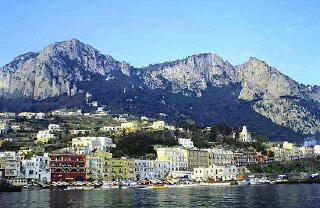
 Capri
Capri

Capri is an island of limestone rock that represents the outermost tip of the mountain chain on the Sorrentine peninsula.
The coastline, whose dolomite cliffs fall right to the sea in many spots, is dotted with countless caves and surrounded by reefs whose shapes suggest fantastic creations.
Mount Tiberio (334 m.), to the east, and Mount Solaro (589 m.) to the west are the two main peaks on the island. Between these heights, on a saddle-shaped ridge connecting the Marina Grande, ("Large Marina") - north end - and the Marina Piccola, ("Small Marina") to the south - is the town of Capri (138 m.). The other town, Anacapri (286 m.), sits in the large, verdant plain to the west of Mount Solaro.
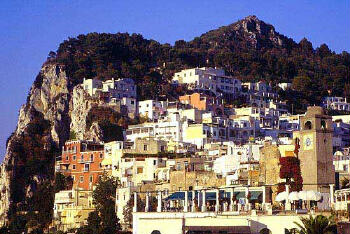 Capri contains a vast variety of plants and flowers, offering no fewer than 850 species and 130 varieties, despite its extremely small surface area, including some rarities, such as the dwarf palm, which has survived in a number of inaccessible areas. In terms of wildlife, many species of marine animals enrich the surrounding sea. On land, there are many types of non-migratory birds, such as the large diomedei gulls, and there are also reptiles, whose number includes the very rare lizard of the Faraglioni rocks.
Capri contains a vast variety of plants and flowers, offering no fewer than 850 species and 130 varieties, despite its extremely small surface area, including some rarities, such as the dwarf palm, which has survived in a number of inaccessible areas. In terms of wildlife, many species of marine animals enrich the surrounding sea. On land, there are many types of non-migratory birds, such as the large diomedei gulls, and there are also reptiles, whose number includes the very rare lizard of the Faraglioni rocks.
After visiting Capri in 29 BC, Caesar Augustus was so taken with the islandls beauty that he bought it from the city of Naples, giving up the nearby island of Ischia - much larger and licher - in return. Legend has it that his successor, Tiberius, who lived there from 27 to 37 AD, built twelve villas, dedicating them to the twelve gods of Olympus.
From the most magnificent of these dwellings, the "Villa Jovis", he ruled the Roman Empire. Other emperors spent time in Capri, which was visited and inhabited by Roman nobles up through the IVth century AD.
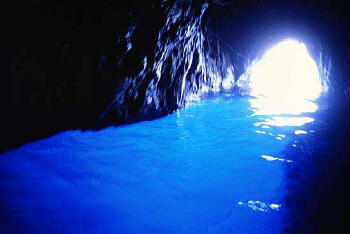 Returned to the ownership of the Dutchy of Naples, the island was raided by the Saracens in the sixth and seventh centuries, and was dominated during various periods in the years that followed by the Longobards, the Normans, the Angevins, the Aragonese and, finally, the Spanish.
Returned to the ownership of the Dutchy of Naples, the island was raided by the Saracens in the sixth and seventh centuries, and was dominated during various periods in the years that followed by the Longobards, the Normans, the Angevins, the Aragonese and, finally, the Spanish.
The island experienced a period of renewed good fortune in the 17th and 18th centuries
Beginning in the second half of the 18th century, the island became a preferred destination of the Bourbons, who went there to hunt quayle and simply to travel. Many of the increasing number of visitors from the north who came to take in the magnificently primitive nature of the south included the island in their travel plans and gave the world its first images of Capri.
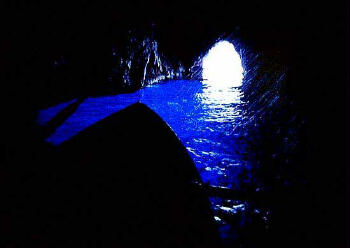 Starting in the first half of the last century, in the wake of the discovery of The Blue Grotto, or "Blue Cave", the flow of Italian and foreign tourists began.
Starting in the first half of the last century, in the wake of the discovery of The Blue Grotto, or "Blue Cave", the flow of Italian and foreign tourists began.
from the end of the 1800's until the Second World War, many chose the island as their year-round or seasonal residence, building villas and contributing to the creation of the multi-facetted, multi-lingual, cosmopolitan colony that made the name Capri famous and established the island's myth.
The existence of the Blue Grotto was revealed in August 1826 by the German writer August Kopisch, who described its extraordinary beauty. Since then the Blue Grotto has become the emblem of the island of Capri; but the enchantment of this place goes back further in time, when it was well known by the Romans, as proved by the antique statues which were found in the Grotto.The grotto was known to the locals under the name of Gradola, after the nearby landing place of Gradola, but it was avoided because it was said to be inhabited by witches and monsters.
The sunlight, passing through an underwater cavity and shining through the seawater, creates a blue reflection that illuminates the cavern.
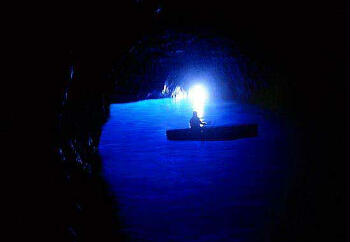 To get to the Blue Grotto, there are motorboats that leave from the port of Marina Grande and that besides going round the island, stop off here. You can also get to the Grotto by bus (from Anacapri) or by taxi as, after reaching the entrance to the grotto, you have to get into little rowing boats, that take a maximum of two or three persons, and lying on the bottom of them, you are taken through the natural narrow opening. The grotto cannot be visited during bad weather.
To get to the Blue Grotto, there are motorboats that leave from the port of Marina Grande and that besides going round the island, stop off here. You can also get to the Grotto by bus (from Anacapri) or by taxi as, after reaching the entrance to the grotto, you have to get into little rowing boats, that take a maximum of two or three persons, and lying on the bottom of them, you are taken through the natural narrow opening. The grotto cannot be visited during bad weather.
 Return to the Fridge door
Return to the Fridge door